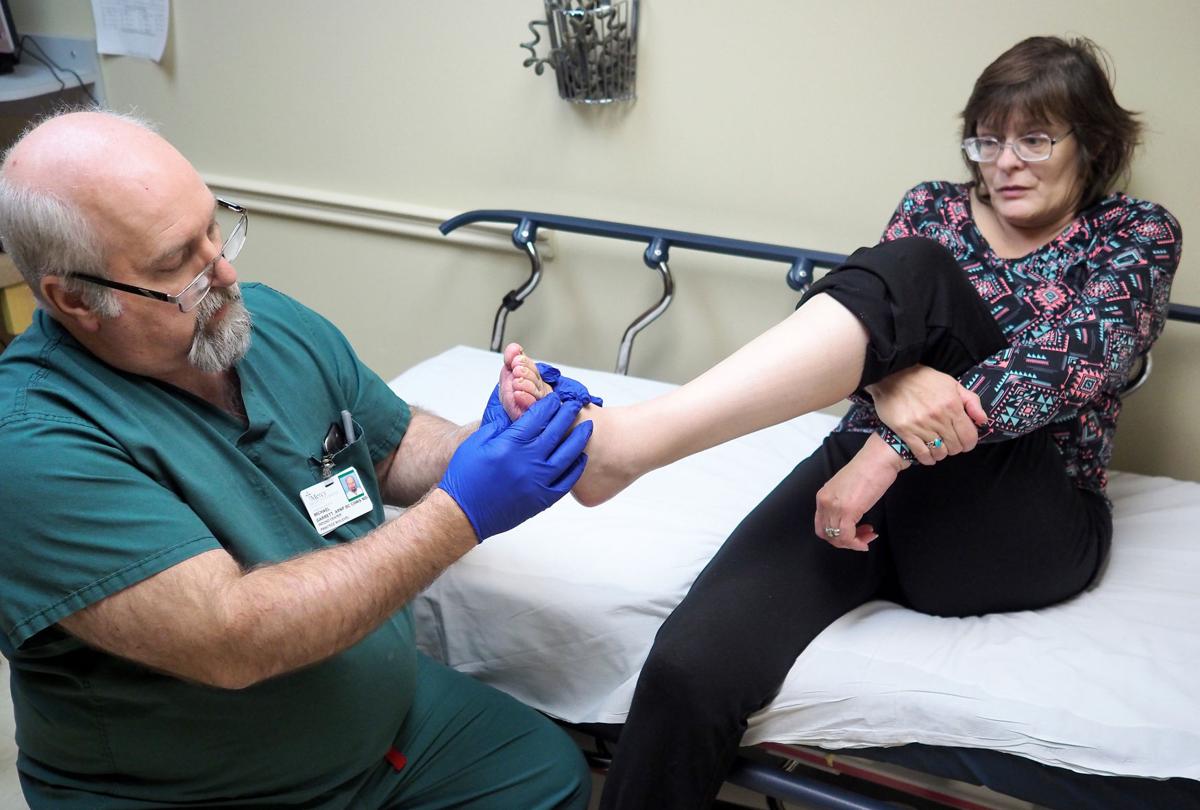SIOUX CITY | After her mother was injured in a car crash, Mary Anton focused so much on her care that she neglected her own health.
The 53-year-old Anthon, Iowa, woman stopped taking the medication she needed to control her type 2 diabetes and a sore on her left foot began to fester. She first visited her primary care provider, who tried to treat the ulcer for two months to no avail. Anton was then referred to Mercy Medical Center's Wound Care Center last summer.
Michael Garrett, an advanced registered nurse practitioner and certified hyperbaric wound specialist at Mercy, said Anton's diabetes was way out of control, as was her ulcer. He said he worked closely with Anton's doctor and a diabetic educator to get her A1C and her blood pressure within a normal range.
"If it would've been any worse, she would've had an amputation of the first two toes, because she had full loss of all the tissues that you have between the skin and the bone," Garrett said. "The two layers -- epidermis and dermis -- of the skin were gone. The fat pad was gone. The muscle was gone."
Thanks to a cutting-edge treatment, Anton not only kept her toes, but also maintained normal movement in her foot. Grafix, cryopreserved human placental tissue, was applied to the surface of Anton's wound. She also received hyperbaric oxygen therapy, a medical treatment in which patients breathe 100 percent oxygen while under pressure in a hyperbaric chamber, and wore a total contact cast to maximize offloading.
"This was the best Christmas present," said Anton, whose ulcer took nearly 23 weeks to heal.

Mary Anton, of Anthon, Iowa, received Grafix, cryopreserved placental tissue, which healed a diabetic ulcer on her left foot.
Jim Lee, Sioux City JournalAn estimated 30.3 million people in the United States have been diagnosed with diabetes, which damages blood vessels and nerves, particularly in the feet. About 25 percent of people with diabetes will experience a foot ulcer in their lifetime, according to the U.S. Food and Drug Administration. And some of them will require amputation if their ulcer fails to heal.
Garrett said a lot of patients with diabetes develop peripheral neuropathy, the loss of protective sensation, in their hands and feet. He recalled a patient who played an entire round of golf with a golf ball in his shoe, which left the patient with a painful blackened toe.
"We recommend that people look at their feet every day, but at minimum at least once a week," he said. "Make sure that there's nothing red, nothing hot, nothing abnormally looking," he said. "Keep your nails trimmed. Long nails when you're sleeping tend to injure the opposite extremity."
While treatments for diabetic ulcers have advanced, Garrett said a patient's access to providers, wound care specialists and podiatrists who are "savvy" about the latest breakthroughs in wound care could determine whether a patient keeps their foot or not.
"If you get referred to an orthopedic doctor or a general surgeon because you have a necrotic foot, many times they may just say, 'This is never going to heal. We might as well just cut it off,'" he said. "If you get referred to someone who deals with wounds every day it may still end up as an amputation, but you're going to get every fighting chance with all the advanced modalities to try and save your foot."

Michael Garrett, an advanced registered nurse practitioner at Mercy Medical Center, examines Mary Anton's foot in the hospital's Wound Center. Anton, of Anthon, Iowa, was at risk of losing the first two toes on her left foot after developing a diabetic foot ulcer.
Jim Lee, Sioux City JournalGarrett said Grafix is composed of a "gender neutral" tissue in the lining between the placenta and amniotic sac. After the tissue is harvested, he said the tissue bank screens the tissue for various diseases and bacteria. If the tests come back negative, Garrett said the tissue is cryopreserved for use.
He said Mercy was approved to use the product on patients who have an open ulcer with exposed bone or tendon, but no bone infection.
"There's a warming process to room temperature. Once it's room temperature you can apply it to the ulcer," said Garrett, who compared Grafix to the consistency of mucus. "You have to lay it out flat. Usually we take a neutral collagen and transfer it on to that. Then we can cut it, pack it, wrap it, twist it and do anything else we need to do with it."
As the collagen naturally dissolves, Garrett said Grafix attaches to the tissue and begins the healing process.
"She was perfect for this treatment," Garrett said of Anton. "The way it just kind of took off was amazing. It really is a game changer for these types of injuries and these types of ulcers."




